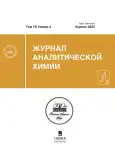Том 79, № 4 (2024)
- Жылы: 2024
- Мақалалар: 7
- URL: https://journals.rcsi.science/0044-4502/issue/view/17023
Бүкіл шығарылым
REVIEWS
Microextraction isolation and concentration of mycotoxins for their determination in food products
Аннотация
Mycotoxins are among the most dangerous natural contaminants of food products. The review discusses the principles of microextraction methods (liquid-liquid and solid-phase microextraction) used for the isolation and concentration of mycotoxins from food products for their subsequent determination by various physico-chemical methods of analysis. The capabilities and limitations of the discussed methods, as well as examples of their practical application, are described.
 291-314
291-314


Foreign experience in determining the group hydrocarbon composition of petroleum feedstock and petroleum products
Аннотация
Determination of the group hydrocarbon composition (saturated and aromatic hydrocarbons, resins, asphaltenes) of petroleum dispersed systems is predominantly carried out using chromatographic analysis methods: liquid adsorption chromatography, high-performance liquid chromatography, thin-layer chromatography with flame ionization detection. The specificity of standard methods developed for the analysis of petroleum feedstock and petroleum products using a particular method often results in the incompatibility of results both in terms of the nomenclature of the identified hydrocarbon groups and the determined concentration values. This review provides a comparative assessment of chromatographic methods for analyzing the group hydrocarbon composition of petroleum feedstock and petroleum products, their features, advantages, and disadvantages. The main options for modifying standard methods aimed at achieving correlation between the results obtained by different analysis methods are described.
 315-331
315-331


ORIGINAL ARTICLES
Chemical sample preparation of plant materials in tunnel-type microwave digestion systems for elemental analysis
Аннотация
Analyzing plant materials is essential for environmental monitoring, analytical control of food products, and medicinal raw materials. A review of global practices has shown that there are still no standard proceedings for chemical sample preparation suitable for all plant types without restrictions on the range of elements determined. Creating a standardized scheme for plants is feasible, as the macro composition of any plants consists of at least 90% organic compounds (cellulose, protein, lipids, etc.), whose mineralization results in the formation of water and a gaseous phase. In this study, certified plant samples were mineralized in a tunnel-type microwave digestion system MultiVIEW (SPC SCIENCE, Canada) with variations in analytical sample sizes, composition and volume of reagents, options for adding the reaction mixture, and vessel heating modes for simultaneous determination of a wide range of elements using inductively coupled plasma atomic emission spectrometry. The completeness of dissolution (the degree of correspondence between found and certified contents) was used as one of the criteria for the optimality of sample preparation conditions. It was shown that with a three-stage heating regime of the vessels (heating rate at the first stage 2.76 оC/min) with a sample weight of 0.5 g and separate sequential addition of the reaction mixture (4 ml HNO3, 1.5 ml H2O2, 1 ml HCl, and 0.05 ml HF), it is possible to reliably determine typical plant contents of Si, Al, Mg, Ca, Fe, Na, K, Ba, Sr, Rb, P, B, Mn, Ti, Ni, V, Cu, Zn.
 332-351
332-351


Gas extraction generation of gas mixtures of polar organic compounds at trace concentration levels
Аннотация
The patterns of generating gas mixtures of polar organic compounds at the level of their MAC (several µg/m³) were studied using the method of continuous gas extraction from aqueous solutions with a known concentration in combination with dilution by a stream of diluent gas. The necessary distribution coefficients of phenol, isomeric cresols, nitrobenzene, and alkanols С4–С6 between the aqueous and gas phases (nitrogen) were determined. A two-stage generation scheme is proposed, based on saturating the sorbent (activated carbon) with a flow of extraction gas containing the target components at a specified concentration, followed by desorption by a flow of pure extraction gas.
 352-360
352-360


False positive signals in the detection of explosives using ion mobility spectrometry: organic acids
Аннотация
Twenty varieties of fruits (fruits, berries, vegetables) were studied, the presence of trace amounts of which in samples causes false positive signals in explosives detectors based on the ion mobility spectrometry method. These signals are due to the presence of organic acids in the fruits, which effectively form negative ions. The mobilities of some types of these acid ions are close to or coincide with the mobilities of explosive substance ions. Specifically, ions of ascorbic or citric acid, malic acid, tartaric acid, adduct anions of oxalic and malic acids, adduct anions of citric and malic acids are identified by the detector as ions of 2,4-dinitrotoluene, 1,2,3-trinitroxypropane, octogen, and 2,4,6-trinitrotoluene, adduct anions of hexogen and lactic acid, respectively.
 361-372
361-372


Multifunctional polymeric stationary phases with enhanced hydrophilicity grafted with polyethyleneimine and polyglycidol
Аннотация
Two methods for increasing the degree of hydrophilization and screening of the sorbent matrix based on a copolymer of styrene and divinylbenzene grafted with polyethyleneimine quaternized with glycidol are proposed. The first method involves the polymerization of glycidol in the functional layer by varying the pH of the reaction medium, and the second method involves modifying the matrix by oxidizing the double bonds on its surface to obtain anchor epoxy groups. It was demonstrated that in the first method, the optimal approach is the twofold addition of glycidol before and after the addition of alkali, as in this case, the first addition of glycidol is consumed for the quaternization of polyamine, and the second for polymerization in ion-exchange centers. The new method of matrix modification, combined with the developed method of creating hydrophilic layers, significantly reduced the retention of oxyhalides, haloacetic acids, and polarizable anions in ion chromatography with suppressed background conductivity and amino acids in hydrophilic chromatography up to the point of changing the elution order. The obtained stationary phases are suitable for the simultaneous determination of standard inorganic anions, oxyhalides, and anions of haloacetic or alkylphosphonic acids in ion chromatography, as well as for the separation of amino acids, sugars, and vitamins in hydrophilic chromatography.
 373-386
373-386


EVENTS
IV All-Russian conference on analytical spectroscopy
 388–390
388–390











